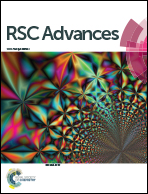Orientational ordering of guest induced structural phase transition coupled with switchable dielectric properties in a host–guest crystal: bis(thiourea) thiazolium chloride†
Abstract
A new thiourea-based supramolecular compound (TA)[(TU)2Cl] (1, TA = thiazolium, TU = thiourea) has been successfully synthesized and systematically characterized, including differential scanning calorimetry (DSC), variable-temperature structural analysis and dielectric measurements. 1 undergoes a structural phase transition at 213.7 K (Tc), accompanied by distinct switchable dielectric anomalies. The TA cation is disordered over four equivalent positions above the Tc and becomes less-disordered over the two equivalent positions below the Tc. The structural relative disorder-order transition of the TA cation contributes to the switching of the dielectric constant between high- and low-dielectric states. Supramolecular inclusion compounds designed with dynamic components have been proved to be a good strategy for searching for new phase transition and switchable dielectric materials.


 Please wait while we load your content...
Please wait while we load your content...